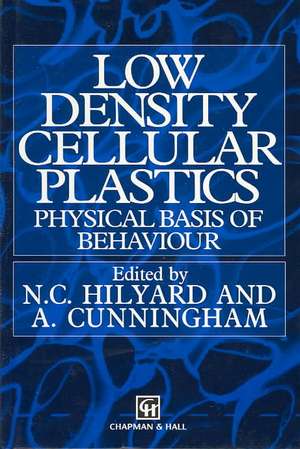Low density cellular plastics: Physical basis of behaviour
Editat de N.C. Hilyard, A. Cunninghamen Limba Engleză Hardback – 30 iun 1994
| Toate formatele și edițiile | Preț | Express |
|---|---|---|
| Paperback (1) | 1547.81 lei 6-8 săpt. | |
| SPRINGER NETHERLANDS – 25 sep 2012 | 1547.81 lei 6-8 săpt. | |
| Hardback (1) | 1552.83 lei 6-8 săpt. | |
| SPRINGER NETHERLANDS – 30 iun 1994 | 1552.83 lei 6-8 săpt. |
Preț: 1552.83 lei
Preț vechi: 1893.71 lei
-18% Nou
Puncte Express: 2329
Preț estimativ în valută:
297.13€ • 311.06$ • 245.86£
297.13€ • 311.06$ • 245.86£
Carte tipărită la comandă
Livrare economică 07-21 aprilie
Preluare comenzi: 021 569.72.76
Specificații
ISBN-13: 9780412584107
ISBN-10: 0412584107
Pagini: 369
Ilustrații: XIV, 369 p.
Dimensiuni: 155 x 235 x 26 mm
Greutate: 0.69 kg
Ediția:1994
Editura: SPRINGER NETHERLANDS
Colecția Springer
Locul publicării:Dordrecht, Netherlands
ISBN-10: 0412584107
Pagini: 369
Ilustrații: XIV, 369 p.
Dimensiuni: 155 x 235 x 26 mm
Greutate: 0.69 kg
Ediția:1994
Editura: SPRINGER NETHERLANDS
Colecția Springer
Locul publicării:Dordrecht, Netherlands
Public țintă
ResearchCuprins
1 Physical behaviour of polymeric foams — an overview.- 1.1 General.- 1.2 Foam formation.- 1.3 Cell structure.- 1.4 Matrix polymer morphology.- 1.5 Thermal behaviour.- 1.6 Stress—strain behaviour.- 1.7 Energy management.- 1.8 Final comments.- References.- 2 Polyurethane flexible foam formation.- 2.1 Introduction.- 2.2 Reaction chemistry.- 2.3 Morphology development.- 2.4 The cell opening mechanism.- 2.5 Conclusions.- Acknowledgements.- References.- 3 Characterizations of polymeric cellular structures.- 3.1 Introduction.- 3.2 Background.- 3.3 Quantitative characterization.- 3.4 Stereology.- 3.5 Difficulties associated with measurement.- 3.6 Optical microscopy.- 3.7 Final comments.- Acknowledgements.- References.- 4 The morphology of flexible polyurethane matrix polymers.- 4.1 Introduction.- 4.2 The dynamics of phase separation.- 4.3 The morphological characterization of foams.- 4.4 Summary.- Acknowledgements.- References.- 5 Heat transfer in foams.- 5.1 Introduction.- 5.2 Conduction heat transfer.- 5.3 Radiative heat transfer.- 5.4 Gas conduction.- 5.5 Overall conductivity.- Acknowledgements.- Appendix A: Lower limit analysis.- Appendix B: List of symbols.- References.- 6 Thermal ageing.- 6.1 Introduction.- 6.2 Theory and modelling.- 6.3 Experimental methods.- 6.4 Different testing methods.- Appendix: List of symbols.- References.- 7 The elastic behavior of low-density cellular plastics.- 7.1 Introduction.- 7.2 Elastic behavior of perfectly ordered two-dimensional foams.- 7.3 Elastic behavior of three-dimensional foams.- 7.4 Future directions.- Acknowledgements.- References.- 8 Hysteresis and energy loss in flexible polyurethane foams.- 8.1 Introduction.- 8.2 Mechanical response.- 8.3 Definitions and relationships.- 8.4 Mechanisms.- 8.5 Static hysteresis.- 8.6Dynamics hysteresis.- 8.7 Ball rebound resilience.- 8.8 Conclusions.- Appendix: List of symbols.- References.- 9 Impact response.- 9.1 Introduction.- 9.2 Macroscopic deformation geometry.- 9.3 Cell geometry and deformation mechanisms.- 9.4 Impact properties.- 9.5 Relation of impact properties to microstructure.- 9.6 Packaging design.- 9.7 Complex impacts.- 9.8 Discussion.- References.- 10 Acoustic characteristics of low density foams.- 10.1 Introduction.- 10.2 Single-wave approximation for foams with a low flow resistivity.- 10.3 Acoustic properties of foams of medium and high flow resistivity.- 10.4 Matrix representation of layered porous materials.- 10.5 Conclusion.- Appendix A: Matrix elements.- References.
Recenzii
The book will be of major interest to polymer or materials scientists concerned with properties and applications of low density cellular polymers. Polymer International










